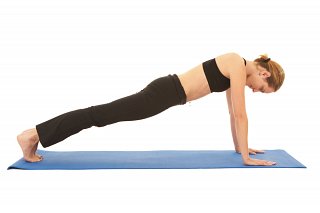Pilates Sample Exercises

Simple yet effective Exercises
The following are some sample pilates exercises to help strengthen your back - especially as you recover from back pain.
However a word of caution - from my experience over the years as a chartered physiotherapist and Pilates instructor, I have commonly seen people who tend to overdo it when starting strengthening exercises for their back. By doing too much too soon, it can lead to further back pain and long term damage to your back. If you are in pain, consult a medical professional before you start exercises.
Strengthening of your back is a slow and steady process. It should be carried out under the guidance of a trained physiotherapist and subsequently Pilates instructor. Patience is required but the long term rewards are truly amazing. Below are a few samples of Pilates back strengthening exercises I use with my own clients. They would typically do them at home on a Pilates mat or towel, as part of a home exercise program.
Warm up exercise before Strengthening Exercises.
Ten minutes of walking, exercise bike or even walking on the spot is adequate. The importance of this general warm up is to increase the circulation to the muscles so as to facilitate their ability to perform in both stretching and strengthening movements. This will reduce the likelihood of injury while performing these exercises.
Activate the deep abdominal muscles in conjunction with all the below exercises (Your abdominal muscles are those core muscles located deep in your tummy and the pelvis). To activate your deep abdominal muscles:
- draw up your pelvic floor,
- pull your belly button in towards your spine and imagine your rib cage flattening down towards your hips.
Read more about Exercises to strengthen your core muscles here
Hold this contraction during the following exercises to give the deep abdominal muscles a work out in conjunction with your torso. Your abdominal contractions should be sustainable for a length of time, therefore, a gentle contraction is what is required not a maximum effort one.
Sponsored links
So here we go…
Sample Pilates Exercises to strengthen the back
a. Bridging:
- Lie flat on your back, knees bent, feet flat on the floor.
- Knees and feet hip distance apart.
- Tighten your abdominals.
- Lift your buttocks off the floor keeping your abdominals engaged.
- Your shoulders and knees should be in a straight line.
- Hold for 5 seconds.
- Slowly lower buttocks to the floor. - Repeat ten times.

b. The Plank:
- Lie on your stomach.
- Place elbows and forearms on the floor.
- Your elbows should be under your shoulder.
- Lift your body off the floor.
- You should be balancing on your elbows and toes.
- Your back and legs should be straight like a plank.
- Engage your abdominals.
- Hold position for 15 seconds and slowly lower down. - Repeat 10 times.

c. Swimming Prep
- On your hands and knees, take what is known as a table top position.
- Make sure your hands are below your shoulders, knees below your hips. Back Straight
- Extend your right arm and left leg out fully, keeping your pelvis level.
- Return to table top
- Then extend your left arm and right leg out fully, keeping your pelvis level.
- Return to table top and repeat the cycle slowly 10 times.

So these are just three Pilates exercises that we would use to help strengthen the back, and part of a range of exercises that could be used in back pain management or to maintain a healthy back.
DISCLAIMER
While the content and materials contained in the articles on this website have been written & researched by Sally Ann Quirke, a professional, practising & fully qualified Chartered Physiotherapist (Physical Therapist) based in Ireland, they are provided for general information and educational purposes only. They do not constitute medical advice on any particular individual situation. Please see your Chartered Physiotherapist or other medical practitioner for full and individual consultation.
Please read the full disclaimer here.
Cookies and Privacy
By using this website, you consent to the use of cookies in accordance with our cookie policy. For more information on how we use cookies, please read our cookie policy here.
